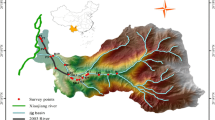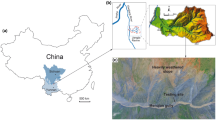Abstract
Debris flow simulations are useful for predicting the sediment supplied to watersheds from upstream areas. However, the topographic conditions upstream are more complicated than those downstream and the relationship between the topographic conditions and debris flow initiation is not well understood. This study compared the use of several entrainment rate equations in numerical simulations of debris flows to examine the effect of topographic conditions on the flow. One-dimensional numerical simulations were performed based on the shallow water equations and three entrainment rate equations were tested. These entrainment rate equations were based on the same idea that erosion and the deposition of debris flows occur via the difference between the equilibrium and current conditions of debris flows, while they differed in the expression of the concentration, channel angle, and sediment amount. The comparison was performed using a straight channel with various channel angles and a channel with a periodically undulating surface. The three entrainment rate equations gave different amounts of channel bed degradation and hydrographs for a straight channel with a channel angle greater than 21° when water was supplied from upstream at a steady rate. The difference was caused by the expression of the entrainment rate equations. For channels with little undulation, the numerical simulations gave results almost identical to those for straight channels with the same channel angle. However, for channels with large undulations, the hydrographs differed from those for straight channels with the same channel angle when the channel angle was less than 21°. Rapid erosion occurred and the hydrograph showed a significant peak, especially in cases using the entrainment equation expressed by channel angle. This was caused by the effects of the steep undulating sections, since the effect increased with the magnitude of the undulation, suggesting that a debris flow in an upstream area develops differently according to the topographic conditions. These results also inferred that numerical simulations of debris flow can differ depending on the spatial resolution of the simulation domain, as the resolution determines the reproducibility of the undulations.
Similar content being viewed by others
References
Armanini A, Fraccarollo L, Rosatti G (2009) Two-dimensional simulation of debris flows in erodible channels. Computers & Geosciences 35: 993–1006. DOI: 10.1016/j.cageo.2007.11.008
Denlinger RP, Iverson RM (2001) Flow of variably fluidized granular masses across three-dimensional terrain: 2. Numerical prediction and experimental tests. Journal of Geophysical Research 106: 553–566. DOI: 10.1029/2000JB900330
Egashira S, Ashida K, Sasaki H (1988) Mechanics of debris flow in open channel. Proceedings of the Japanese Conference on Hydraulics, Japan Society of Civil Engineers 32: 485–490. (In Japanese with English summary)
Egashira S, Miyamoto K, Itoh T (1997) Constitutive equations of debris flow and their applicability. In: Proceedings of the 1st International Conference on Debris-Flow Hazards Mitigation, San Francisco, California, US, 7 -9 August 1997. pp 340–349.
Hsu SM, Chiou LB, Lin GF, et al. (2010) Applications of simulation technique on debris-flow hazard zone delineation: a case study in Hualien County, Taiwan. Natural Hazard and System Sciences 10: 535–545. DOI: 10.5194/nhess-10-535-2010
Hunger O, Evans SG (2004) Entrainment of debris in rock avalanches: An analysis of a long run-out mechanism. Geological Society of America Bulletin 116: 1240–1252. DOI: 10.1130/B25362.1
Itoh T, Miyamoto K (2002) Study on one dimensional numerical simulation of debris flow. Proceedings of hydraulic engineering, JSCE 46: 671–676. (In Japanese with English summary)
Ikeda A, Mizuyama T, Sugiura N, Hasegawa Y (2011) Deformation of stream bed deposit and runoff process at debris flow initiation zone. In: Proceedings of the 5th International Conference on Debris-Flow Hazards Mitigation, Padua, Italy, 14-17 June 2011. pp 91–99.
Imaizumi F, Tsuchiya S, Ohsaka O (2005) Behavior of debris flows located in a mountainous torrent on the Ohya landslide, Japan. Canadian Geotechnical Journal 42: 919–931. DOI: 10.1139/t05-019
Imaizumi F, Sidle RC, Tsuchiya S, et al. (2006) Hydrogeomorphic processes in a steep debris flow initiation zone. Geophysical Research Letters 33: L10404. DOI: 10.1029/2006GL026250
Iverson RM (2012) Elementary theory of bed-sediment entrainment by debris flows and avalanches. Journal of Geophysical Research 117: F03006. DOI: 10.1029/2011JF002189
Liu J, Nakatani K, Mizuyama T (2012) Hazard mitigation planning for debris flow based on numerical simulation using Kanako simulator. Journal of Mountain Science 9(4): 529–537. DOI: 10.1007/s11629-012-2225-9
McCoy SW, Kean JW, Coe JA, et al. (2012) Sediment entrainment by debris flows: In situ measurements from the headwaters of a steep catchment. Journal of Geophysical Research 117: F03016. DOI: 10.1029/2011JF002278
Miyamoto K, Itoh T (2002) Numerical simulation method of debris flow introducing the erosion rate equation. Journal of the Japan Society of Erosion Control Engineering 55(2): 24–35. (In Japanese with English summary)
Nakagawa H, Takahashi T, Sawada T, et al. (1996) Design hydrograph and evacuation planning for debris flow. Annals of the Disaster Prevention Research Institute, Kyoto University 39 (B-2): 347–371. (In Japanese with English summary)
Nakagawa H, Takahashi T (1997) Estimation of a debris flow hydrograph and hazard area. In: Proceedings of the 1st International Conference on Debris-Flow Hazards Mitigation, San Francisco, California, US, 7 -9 August 1997. pp 64–73.
O’Brien JS, Julien PY, Fullerton T (1993) Two-dimensional water flood and mudflow simulation. Journal of Hydraulic Engineering 119(2): 244–261.
Osti R, Egashira S (2009) Hydrodynamic characteristics of the Tam Pokhari glacial lake outburst flood in the Mt. Everest region, Nepal. Hydrological Processes 23: 2943–2955. DOI: 10.1002/hyp.7405
Peng H, Zhao Y, Cui P, et al. (2011) Two-dimensional numerical model for debris flows in the Jiangjia gully, Yuunan province. Journal of Mountain Science 8(6): 757–766. DOI: 10.1007/s11629-011-2043-5
Suzuki T (2013) Method for processing an erosion rate equation in numerical simulation of debris flow. Journal of the Japan Society of Erosion Control Engineering 65(5): 21–28. (In Japanese with English summary)
Suzuki T, Hotta N, Miyamoto K (2009) Numerical simulation method of debris flow introducing the non-entrainment erosion rate equation, at the transition point of the riverbed gradient or the channel width and in the area of sabo dam. Journal of the Japan Society of Erosion Control Engineering 62(3): 14–22. (In Japanese with English summary)
Suzuki T, Hasegawa Y, Mizuno H, et al. (2011) Numerical simulation method of debris flow introducing the nonentrainment erosion rate equation, at the transition point of the riverbed gradient or the channel width and in the area of sabo dam. In: Proceedings of the 5th International Conference on Debris-Flow Hazards Mitigation, Padua, Italy, 14-17 June 2011. pp 615–622.
Tai YC, Kuo CY (2008) A new model of granular flows over general topography with erosion and deposition. Acta Mechanica 199: 71–96. DOI: 10.1007/s00707-007-0560-7
Takahama J, Fujita Y, Kondo Y (2000) Comparison of simulation models of debris flow. Proceedings of hydraulic engineering, Japan Society of Civil Engineers 44: 687–692. (In Japanese with English summary)
Takahama J, Fujita Y, Hachiya K, Sakamoto M (2002) Study on debris flow behavior in a region around a point of abrupt slope reducing. Proceedings of hydraulic engineering, JSCE 46: 683–688. (In Japanese with English summary)
Takahashi T (1977) A mechanism of occurrence of mud-debris flows and their characteristics in motion. Annals of the Disaster Prevention Research Institute, Kyoto University 20 (B-2): 405–435. (In Japanese with English summary)
Takahashi T (1980) Debris flow on prismatic open channel. Journal of the Hydraulics Division, ASCE 106(3): 381–396.
Takahashi T (2007) Debris Flow: Mechanics, Prediction and Countermeasures. Taylor and Francis, Balkema. pp 448.
Takahashi T, Kuang SF (1986) Formation of debris flow on varied slope bed. Annals of the Disaster Prevention Research Institute, Kyoto University 29 (B-2): 345–359. (In Japanese with English summary)
Takahashi T, Nakagawa H (1991) Prediction of Stony Debris Flow Induced by Severe Rainfall. Journal of the Japan Society of Erosion Control Engineering 44(3): 12–19. (In Japanese with English summary)
Takahashi T, Nakagawa H, Satoh H (1988) Sediment hazard risk on a debris flow fan area. Annals of the Disaster Prevention Research Institute, Kyoto University 31 (B-2): 655–676. (In Japanese with English summary)
Takahashi T, Inoue M, Nakagawa H, Satofuka Y (2000) Prediction of sediment runoff from a mountain watershed. Proceedings of hydraulic engineering, Japan Society of Civil Engineers 44: 717–722. (In Japanese with English summary)
Tsai Y (2007) A debris-flow simulation model for the evaluation of protection structures. Journal of Mountain Science 4(3): 193–202. DOI: 10.1007/s11629-007-0193-2
Tsubaki T, Hashimoto H, Suetsugi T (1982) Grain stresses and flow property of debris flow. Proceedings of the Japan Society of Civil Engineers 317: 79–91. (In Japanese with English summary)
Tsunetaka H, Hotta N, Suzuki T, Ishikawa S (2015) Influence of topographic condition on numerical simulation of debris flow. Journal of the Japan Society of Erosion Control Engineering: 68(1): 3–12. (In Japanese with English summary)
Wu YH, Liu KF, Chen YC (2012) Comparison between FLO-2D and Debris-2D on the application of application of assessment of granular debris flow hazard with case study. Journal of Mountain Science 10(2): 293–304. DOI: 10.1007/s11629-013-2511-1
Zhou GD, Cui P, Tang JB, et al. (2015) Experimental study on the triggering mechanisms and kinematic properties of large debris flows in Wenjia Gully. Engineering Geology 194: 52–61. DOI: 10.1016/j.enggeo.2014.10.021
Author information
Authors and Affiliations
Corresponding author
Additional information
http://orcid.org/0000-0001-6312-325X
http://orcid.org/0000-0001-7831-6193
http://orcid.org/0000-0001-9964-6247
Rights and permissions
About this article
Cite this article
Hotta, N., Tsunetaka, H. & Suzuki, T. Interaction between topographic conditions and entrainment rate in numerical simulations of debris flow. J. Mt. Sci. 12, 1383–1394 (2015). https://doi.org/10.1007/s11629-014-3352-2
Received:
Accepted:
Published:
Issue Date:
DOI: https://doi.org/10.1007/s11629-014-3352-2




